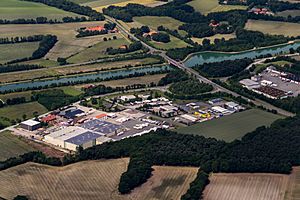Operation Garlic facts for kids
Quick facts for kids Operation Garlic |
|||||
|---|---|---|---|---|---|
| Part of Second World War | |||||
 The Dortmund-Ems Canal in 2014 |
|||||
|
|||||
| Belligerents | |||||
| Commanders and leaders | |||||
| Strength | |||||
| 8 Lancasters, 6 Mosquitos on each raid | Flak Gun defences | ||||
| Casualties and losses | |||||
| 6 aircraft destroyed | Little to no damage | ||||
Operation Garlic was the name for two air attacks during World War II. These attacks happened on September 14-16, 1943. The target was the Dortmund-Ems Canal in Germany. 617 Squadron of the British Royal Air Force carried out these missions. Sadly, the attacks did not cause much damage to the canal. The squadron also lost many planes and brave aircrews.
Why Attack the Canal?
The Dortmund-Ems Canal was a very important waterway. It was like a major highway for German industries. Because of this, it was a good target for the Allies. The plan was to drop huge 12,000-pound bombs on an aqueduct. An aqueduct is like a bridge that carries water. The goal was to break the aqueduct and stop boats from using the canal.
These very large bombs were not easy to drop accurately. They had to be dropped from a very low height. This made the mission very dangerous. 617 Squadron was chosen for this job. This squadron was known for its special low-level bombing skills. They had just completed the famous "Dambusters" raid.
The Missions
The first attack was planned for the night of September 14, 1943. Eight Avro Lancaster bombers from 617 Squadron were part of the mission. Six de Havilland Mosquito planes from other squadrons joined them. The Mosquitos were there to help protect the Lancasters.
- First Attempt: Fog and Tragedy*
The planes started their journey over the North Sea. But thick fog and mist covered the target area. Because of the bad weather, the planes were called back. On the way home, a sad accident happened. Squadron Leader (S/Ldr) Maltby's plane crashed into the sea. It might have hit another plane returning from a different mission. All the crew members on his plane died. Another pilot, Flight Lieutenant (F/Lt) Shannon, circled the crash site for two hours. He waited for rescue teams to arrive. Only Maltby's body was found.
- Second Attempt: Bad Visibility*
The attack was tried again the next night, September 15-16. The same Lancaster planes were used. F/Lt Martin took Maltby's place. The target area was near a city called Munster. Here, the canal split into two parts. The attacking force was divided into two groups. Each group had four Lancasters and three Mosquitos. There were also two extra Lancasters as backup. The Mosquitos' main job was to protect the bombers from German anti-aircraft guns, called flak.
Pilots reported that visibility was very poor during this second raid. It was hard to find the exact target. This made the mission even more difficult and dangerous.
What Happened to the Planes?
This table shows what happened to the planes and their commanders during the raids:
| Commander | Returned? | Notes |
|---|---|---|
| Wg-Cdr Holden | No | He was the leader of the raid. His plane was shot down by flak. |
| S/Ldr Maltby | No | He was the second-in-command. His plane crashed on the first attack while returning. |
| F/Lt Knight | No | His plane was damaged when it hit a tree. He managed to let his crew parachute out. But Knight could not land the plane and was killed. |
| F/Lt Wilson | No | He asked for permission to attack. Nothing more was heard from his plane after that. |
| F/Lt Allsebrook | No | He dropped his bombs. But contact with his plane was lost soon after. |
| P/O Divall | No | He was heard on the radio. He dropped his bomb, then his plane crashed. |
| F/Lt Shannon | Yes | Shannon dropped his bomb. It exploded near the canal's path on the east side. |
| F/Lt Martin | Yes | He dropped his bomb close to the canal. He took charge of the remaining planes after others were lost. |
| P/O Rice | Yes | He could not find the canal because of the bad visibility. So, he returned to base. |
All the Mosquito planes returned safely from the mission.
After the Attack
Operation Garlic was not successful in damaging the canal much. The canal was finally broken the next year. On the night of September 23-24, 1944, planes from 617 Squadron attacked the canal again. This time, they used a more powerful bomb called the Tallboy bomb. This bomb caused a "seismic effect," meaning it shook the ground like a small earthquake. This powerful bomb finally broke the canal. It stayed out of use for the rest of the war.

